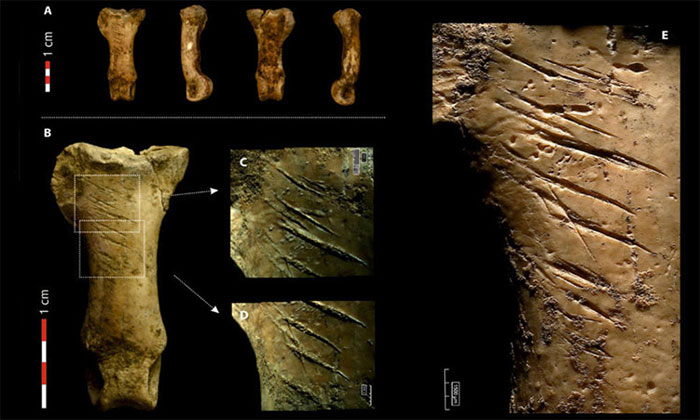Trace necklace with eagle claw 40,000 years old
The Neanderthals could have cut off the toes of an emperor's eagle, an endangered species, to get a claw as a necklace.
The team of experts found the left toe bone of an eagle in Foradada cave, Calafell, since 2015. After the study, they thought that the bone fragment was about 40,000 years old, much newer than similar specimens. Previous findings.

The cuts on the bones of the eagle's toes.(Photo: IFL Science).
Neanderthals' custom of using claws as jewelry began to spread in southern Europe about 120,000 years ago. The bone in the Foradada cave was used at the end of the Neanderthal period, before this group of people became extinct. This is the latest traces of Neanderthals used as jewelry and also the first time such traces were found on the Iberian Peninsula.
The new discovery is one of the rare evidences that ancient people used animal parts as symbolic objects instead of practical purposes. It also contributes to the complex cultural life of Neanderthal. Experts have found eagle claws in parts of Europe where Neanderthals once lived. Some previous studies also indicated that this ancient group of people could use marine shells as a necklace to show social status.
The team used a 3D model on a computer to analyze cuts in bone. They found them to have artificial traces, meaning they were influenced by ancient tools. According to Antonio Rodriguez-Hidalgo, a researcher at the African Institute of Evolution, this may be the last necklace created by Neanderthals.
Juan Ignacio Morales, co-author of the study, said that using eagle claws as a decoration could be a cultural transfer of Neanderthals to modern people. Modern people adopted this custom after coming to England.
Experts have discovered the toe bones of birds of prey in many places where Neanderthals lived in ancient times. The oldest specimens are located in Croatia, which existed some 130,000 years ago, before modern humans arrived. They are now considered the oldest symbolic artifacts of the Neanderthals.
- The eagle owl lays eggs after 23 years is thought to be male
- Digging a 1,700-year-old strange gold ring in Estonia
- Ancient people know how to make jewelry from 130,000 years ago
- Found 1,900 year old eagle statue between London
- China: Found an 800-year-old gold necklace in a wreck
- The 29 million-year-old stone on the necklace of pharaoh Tutankhamun
- The albino eagle appears in the United States
- Necklace puffs up to save lives
- Veil watch for the health of pets Voyce
- Eagles are so strange in appearance that everyone believes that they are ... masquerade
- Giant Eagle Philippines
- The most dangerous birds on the planet
 Discovered an ancient centipede fossil 99 million years old
Discovered an ancient centipede fossil 99 million years old Discovered bat-like dinosaurs in China
Discovered bat-like dinosaurs in China Discovered a 200-year-old bronze cannon of the coast
Discovered a 200-year-old bronze cannon of the coast Discover 305 million-year-old spider fossils
Discover 305 million-year-old spider fossils